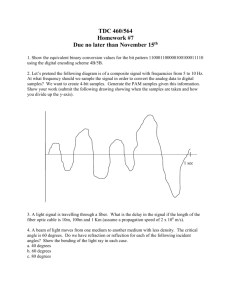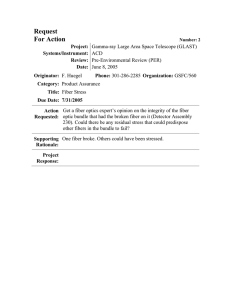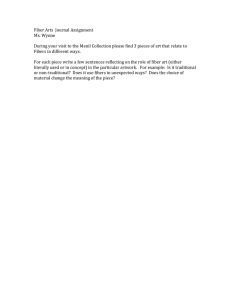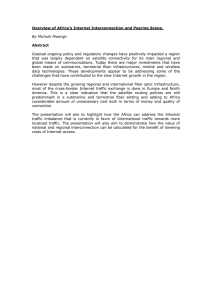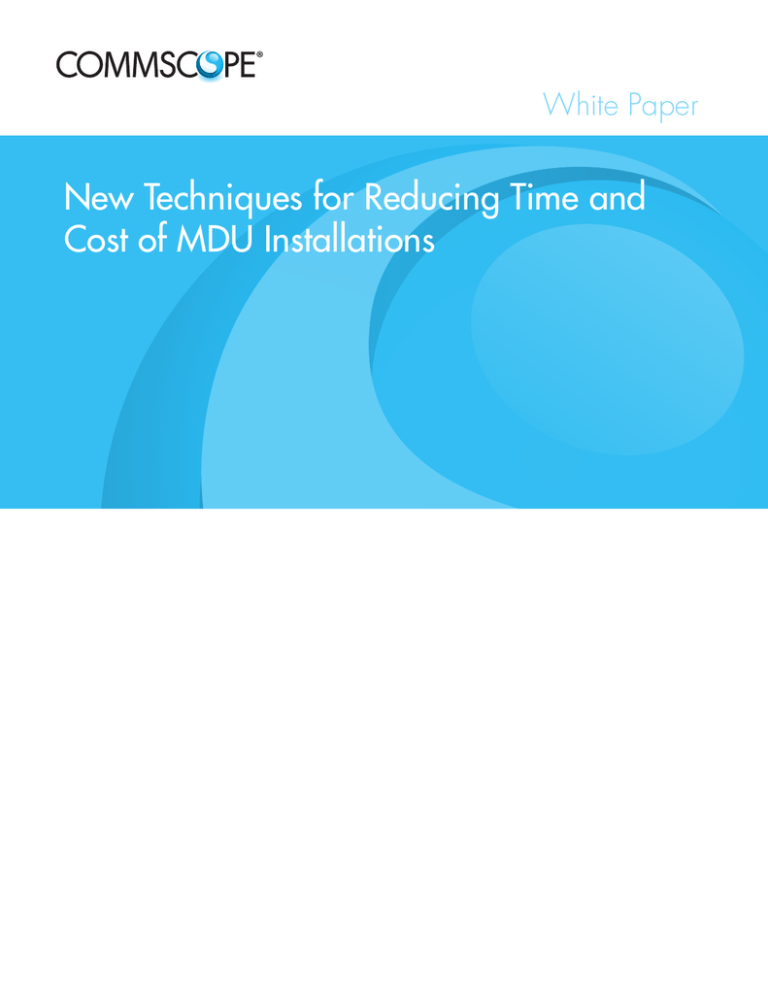
White Paper
New Techniques for Reducing Time and
Cost of MDU Installations
Miniature Outside Plant Plug-and-Play
Solutions
A critical goal for bringing the promise of fiber to residential subscribers
is to install flexible and reliable fiber-to-the-premise (FTTH) architectures at
the lowest possible cost. Multiple Dwelling Units (MDUs) present particular
challenges in this, as the need to deal with conduits and widely varying
layouts requires substantial time to both plan and conduct an FTTH
installation. A new technique, known as Rapid Fiber, provides significant
advantages in achieving this, substantially reducing both the time and cost
of conducting MDU installations. This paper will explore the qualitative
and quantitative advantages of using Rapid Fiber when compared to
current techniques. Although the immense variability in MDU construction
creates differences in the complexity, costs, and time associated with an
installation, Rapid Fiber is an inherently flexible technique and its benefits
carry across a wide range of constructions.
Using Rapid Fiber techniques with appropriate hardware will provide cost-effective
bandwidth delivery by:
•Reducing the overall cost of an installation, providing for greater return on capital investments
•Reducing the amount of planning time required for an installation, thanks to the increased
flexibility of Rapid Fiber hardware.
•Reducing the complexity of an installation by providing a solution for cable storage, slack
storage, connector parking, and splice management requirements
•Reducing or eliminating the number of splices and splice technicians required for an installation.
•Providing faster installation times for the F2 and F3 sections of the network, allowing
companies to begin providing services sooner.
•Reducing the amount of hardware needed by eliminating splice cases
•Allowing installations to be completed by a smaller service team, with most tasks requiring
only 1-2 personnel.
This paper explains the benefits of implementing Rapid Fiber hardware and techniques beginning
at the FDH and working to the ONT. Using Rapid Fiber throughout the installation will streamline
the connection process by reducing labor and splicing time and expenses, enabling faster
deployments and, more importantly, a greater—and faster—return on investment for providers.
Planning the MDU Installation
In any type of MDU, the ability of a Rapid Fiber FDT to store excess cable (up to 200 feet)
simplifies planning an installation. After determining the length of any horizontal runs, the height
of each floor, and adding an error factor for additional bends or turns in the cable path, a
planner can determine exactly how many FDTs with each cable length (100-500 feet) that
the installation will require. Using other methods requires either detailed analysis of the length
of cable between each FDT and the FDH, or requires cutting cables to length on-site. Either
technique can lead to the need for a “do-over” if the length is not correct. With Rapid Fiber,
the need to plan for slack storage is eliminated. In addition, the rapid FDH is available with
a parking lot feature, which eliminates the need for planning any connector parking. Finally,
splice management can be eliminated from the planning process—the only splice required is
connecting the feeder cable to the FDH.
2
Conducting the MDU Installation
The significant advantage to a Rapid Fiber MDU system is the speed of installation. If the fiber
network installers can be in and out of the building as quickly as the construction workers, it
creates a huge incentive for the building owner to decide on a FTTH architecture. In practice,
Rapid Fiber allows installers to complete their work and leave the building much sooner than
construction workers in Greenfield deployments, and with minimal disruption to tenants in
brownfield deployments. There are several reasons why this occurs:
•Installers do not need to cut cables to length, have slack storage, or deal with cable storage
during the installation. The spool on the Rapid Fiber Distribution Terminal pays out exactly as
much cable as is needed, and stores its own slack, up to 200 feet.
•Eliminating the need to set up, strip fibers, clean them, align a splice, fuse the fibers, and then
apply a splice protector or sleeve—simply clean and plug a connector.
•Cable pulling can be accomplished with only 1 worker.
For more detail on how Rapid Fiber can be installed faster and for less cost, let’s look at a
few examples:
Large High-Rise MDU
Stub-Pull Configuration: Consider a large high-rise MDU with 23 floors and 15 units per floor.
A 432-fiber indoor FDH is located on the lower level with three 144-fiber stubs. Fiber distribution
terminals (FDTs) reside on each floor of the building that route 12 or 24 fibers down to the indoor
FDH where they are typically spliced in. In this example, 432 fibers would be spliced between
the FDH and the FDTs. 345 individual drop cables would then run from the FDTs to the optical
network terminals (ONTs), creating another splice point.
Loop-Through Configuration: Consider a large high-rise MDU with 23 floors and 15 units per
floor. A 432-fiber indoor FDH is located on the lower level. Several 72-fiber or larger distribution
cables are pulled between the FDH and FDTs on higher floors. On each floor, one of the cables
is routed through the FDT, opened, two of the 12-fiber ribbons are opened and 15 individual
fibers routed to the splice tray in the FDT. In this example, 345 fibers would be spliced between
the FDH and the FDTs. 345 individual drop cables would then run from the FDTs to the optical
network terminals (ONTs), creating another splice point since it is not possible to predict the exact
length of each drop. Per-splice costs are also increased because the splicing technician spends
additional time routing cables through the FDT and opening them.
Rapid Fiber Configuration: Now, let’s create the same infrastructure using Rapid Fiber
architecture. In this case, an FDT again resides on each floor, but an MT connector is mounted
on the stub of each. The fiber is deployed from each FDT to the indoor FDH, also with builtin 12-fiber MT connectors. Each connection is easily plugged into the FDH from every floor.
Installing fiber into an MDU is a simple matter of mounting the enclosures and making Rapid
Fiber connections with the cables. Since distances vary from each FDT to the FDH, a built-in fiber
spool is designed on the FDT. The spool holds up to 500 feet of fiber cable. Therefore, the cable
is easily spooled out to the FDH and plugged in, while any extra cable remains on the spool.
The box containing the spool is small—about 9 x 6 x 3.5 for 12 and 24 fibers – and can be
locked down with a shroud to cover and protect the excess fiber.
3
CommScope (NASDAQ: COMM)
helps companies around the world design,
build and manage their wired and wireless
networks. Our network infrastructure
solutions help customers increase
bandwidth; maximize existing capacity;
improve network performance and
availability; increase energy efficiency;
and simplify technology migration. You will
find our solutions in the largest buildings,
venues and outdoor spaces; in data
centers and buildings of all shapes, sizes
and complexity; at wireless cell sites and
in cable headends; and in airports, trains,
and tunnels. Vital networks around the
world run on CommScope solutions.
Direct cost savings are substantial. In addition to saving on splice cost—which can be as high as
$40 per splice when fully burdened with setup time, capital and maintenance costs, etc.—early
installations of Rapid Fiber have shown a substantial reduction—as much as 10% in labor time
for non-splicing technicians as well. This leads to remarkable cost savings on a per-unit basis:
Item
Splicing costs
Non-Rapid-Fiber
Rapid Fiber
Savings
$50,150
(1254 splices)
$50
(12 splices)
$49,650
$3500
$3275
$250
Non-splicing labor costs
Total Savings
$56,875
Per Living Unit
$146
Advantage: Rapid Fiber
The Rapid Fiber approach to a FTTH infrastructure is made possible by new advances in
connector technology, drop cables, and FDTs. When compared with traditional spliced
architectures, Rapid Fiber provides significant cost savings advantages, as well as savings in time
and manpower.
Rapid Fiber architectures enable more cost-effective, easy-to-manage, reliable FTTH networks.
CommScope is in the forefront of these new developments—providing solutions that will meet the
unique challenges of bringing fiber directly to every subscriber.
www.commscope.com
Visit our website or contact your local CommScope representative for more information.
© 2015 CommScope, Inc. All rights reserved.
Rapid Fiber and all trademarks identified by ® or ™ are registered trademarks or trademarks, respectively, of CommScope, Inc.
This document is for planning purposes only and is not intended to modify or supplement any specifications or warranties relating to CommScope products or services.
WP-107435.2-AE (11/15)

